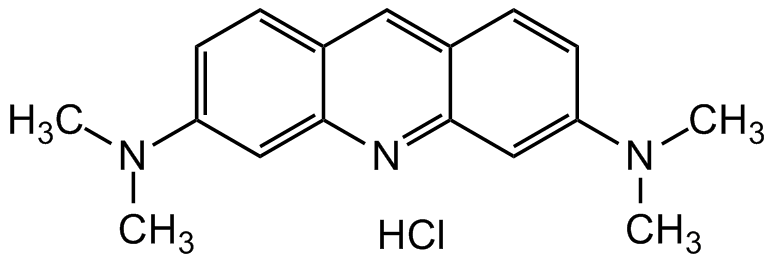Acridine Orange Solution (2% in H2O)
Product Code:
CDX-A0669
CDX-A0669
Regulatory Status:
RUO
RUO
Shipping:
AMBIENT
AMBIENT
Storage:
Short Term: +20°C Long Term: +4°C
Short Term: +20°C Long Term: +4°C
No additional charges, what you see is what you pay! *
| Code | Size | Price |
|---|
| CDX-A0669-L010 | 10 ml | £108.00 |
Quantity:
Prices exclude any Taxes / VAT
Stay in control of your spending. These prices have no additional charges, not even shipping!
* Rare exceptions are clearly labelled (only 0.14% of items!).
* Rare exceptions are clearly labelled (only 0.14% of items!).
Multibuy discounts available! Contact us to find what you can save.
This product comes from: Switzerland.
Typical lead time: 7-10 working days.
Contact us for more accurate information.
Typical lead time: 7-10 working days.
Contact us for more accurate information.
- Further Information
- Documents
- References
- Show All
Further Information
Alternate Names/Synonyms:
3,6-Bis(dimethylamino)acridine hydrochloride; Acridine Orange N; Acridine Orange NO; Acridine Orange NS; Basic Orange 14; Basic Orange 3RN; C.I. 46005; C.I. Basic Orange 14; Rhoduline Orange NO; Sumitomo Acridine Orange NO
Appearance:
Orange to red liquid. 200mg compound in 10ml water.
CAS:
65-61-2
EClass:
32160000
Form (Short):
liquid
Handling Advice:
Protect from light and moisture.
Hazards:
H340-H361
InChi:
InChI=1S/C17H19N3/c1-19(2)14-7-5-12-9-13-6-8-15(20(3)4)11-17(13)18-16(12)10-14/h5-11H,1-4H3
InChiKey:
VSTHNGLPHBTRMB-UHFFFAOYSA-N
Long Description:
Chemical. CAS: 65-61-2. Formula: C17H19N3 . HCl. MW: 301.81. Acridine Orange hydrochloride salt is a cell-permeable metachromatic fluorescent dye that stains DNA and RNA. It is used as a nucleic acid-selective fluorescent cationic dye useful for cell cycle determination and staining dead cells. Being cell-permeable, it interacts with DNA and RNA by intercalation or electrostatic attractions respectively. When bound to DNA, it is very similar spectrally to fluorescein, with an excitation maximum at 502nm and an emission maximum at 525nm (green). When acridine orange associates with RNA, the excitation maximum shifts to 460nm (blue), and the emission maximum shifts to 650nm (red). Acridine orange will also enter acidic compartments such as lysosomes where it becomes protonated and sequestered. At low pH (inside the organelles), it will emit an orange fluorescence (peak at 590nm) and for optimal endosome visualization a blue light excitation (475nm) is used. Thus, acridine orange can be used to visualize primary lysosomes and phagolysosomes that may include products of phagocytosis of apoptotic cells. The dye is often used in epifluorescence microscopy and flow cytometry. It allows for visual detection of nucleic acids on agarose and polyacrylamide gels, can be used for differentiation of dsDNA (green fluorescence) and ssDNA/RNA (red fluorescence) and as a vitality test for determination of living cells. Spectral data: lambdaEx=502nm, lambdaEm=525nm (green, double strands) / lambdaEx=460nm, lambdaEm=650nm (red, single strands) / lambdaEx=475nm, lambdaEm=590nm (orange, acidic conditions).
MDL:
MFCD00005029
Molecular Formula:
C17H19N3 . HCl
Molecular Weight:
301.81
Package Type:
Vial
Product Description:
Acridine Orange hydrochloride salt is a cell-permeable metachromatic fluorescent dye that stains DNA and RNA. It is used as a nucleic acid-selective fluorescent cationic dye useful for cell cycle determination and staining dead cells. Being cell-permeable, it interacts with DNA and RNA by intercalation or electrostatic attractions respectively. When bound to DNA, it is very similar spectrally to fluorescein, with an excitation maximum at 502nm and an emission maximum at 525nm (green). When acridine orange associates with RNA, the excitation maximum shifts to 460nm (blue), and the emission maximum shifts to 650nm (red). Acridine orange will also enter acidic compartments such as lysosomes where it becomes protonated and sequestered. At low pH (inside the organelles), it will emit an orange fluorescence (peak at 590nm) and for optimal endosome visualization a blue light excitation (475nm) is used. Thus, acridine orange can be used to visualize primary lysosomes and phagolysosomes that may include products of phagocytosis of apoptotic cells. The dye is often used in epifluorescence microscopy and flow cytometry. It allows for visual detection of nucleic acids on agarose and polyacrylamide gels, can be used for differentiation of dsDNA (green fluorescence) and ssDNA/RNA (red fluorescence) and as a vitality test for determination of living cells. Spectral data: lambdaEx=502nm, lambdaEm=525nm (green, double strands) / lambdaEx=460nm, lambdaEm=650nm (red, single strands) / lambdaEx=475nm, lambdaEm=590nm (orange, acidic conditions).
Purity:
>98% (HPLC)
SMILES:
CN(C)C1=CC=C2C(N=C(C=C(N(C)C)C=C3)C3=C2)=C1.[H]Cl
Transportation:
Non-hazardous
UNSPSC Category:
Fluorescent Reagents
UNSPSC Number:
41105331
Use & Stability:
Stable for at least 2 years after receipt when stored at +4°C.
Documents
References
(1) F.H. Kasten; Int. Rev. Cytol. 21, 141 (1967) (Review) | (2) J.F. Golden & S.S. West; J. Histochem. Cytochem. 22, 495 (1974) | (3) J.F. Golden, et al.; J. Histochem. Cytochem. 27, 522 (1979) | (4) J.K. Frost, et al.; J. Histochem. Cytochem. 27, 545 (1979) | (5) H.W. Tyrer, et al.; J. Histochem. Cytochem. 27, 552 (1979) | (6) R.N. Paul; Stain Technol. 55, 195 (1980) | (7) S. Mirrett; Inf. Contr. Hosp. Epidemiol. 3, 250 (1982) (Review) | (8) Z. Darzynkiewicz, et al.; Curr. Protoc. Cytom. Chapter 7, Unit 7.3 (2004) (Review) | (9) J. Han & K. burgess; Chem. Revs. 110, 2709 (2010) | (10) R.W. Sabnis; Handbook of Fluorescent Dyes and Probes (2015) | (11) M.P. Thome, et al.; J. Cell Sci. 129, 4622 (2016)



